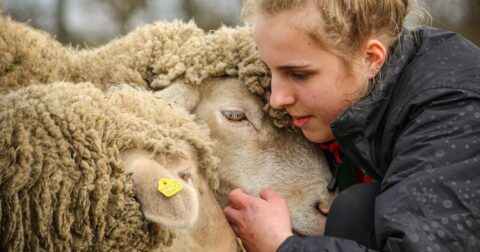News
Senate Finally OKs Plant-Based Milk in Public Schools
Policy•5 min read
Reported
Sanctuaries are implementing pen-pal programs in which children write letters to rescued farmed animals and—with the help of sanctuary workers—receive “replies” from the animals.


Words by Lillie Gardner
Before the pandemic, children visiting Spring Farm Sanctuary in Minnesota could race alongside Rudy the pig, giggle at the chattering chickens Wilma and Betty, and stare into the serene eyes of Pete the Hereford steer. Similar scenes routinely occurred at farm sanctuaries—nonprofit organizations that rescue and advocate for previously farmed animals—across the country. “Kids love animals,” affirms Lauren Barbieri, Youth Program Manager of Catskill Animal Sanctuary in New York. “They just love animals. It’s what they do.”
Farm sanctuaries are recently facing a variety of challenges due to the pandemic. With the timing of COVID-19’s onset, sanctuaries had to cancel events and suspend tours at the start of their popular summer season, resulting in correspondingly low donations and merchandise sales. Shutdowns and social distancing measures are leaving many rescued farmed animals without visitors or, worse, enough volunteers to care for them. Public health precautions, although necessary, are severely limiting sanctuaries’ community outreach to raise awareness of the plight of farmed animals. “I do this for a purpose,” says Johnson, of operating Spring Farm Sanctuary. “I want people to come and really see these animals for who they are and have that [connection] make an impact on them.” Without the in-person connections that are central to farm sanctuaries’ appeal, the threat of closure is a concern for many.
Farm sanctuaries, in an effort to remain operational, are innovating new ways to forge through 2020—and their virtual outreach programs are flourishing. Spring Farm Sanctuary’s virtual classroom tours had so many nationwide requests over the summer that, according to its founder Robin Johnson, tours had to be limited to only Minnesota schools. Catskill Animal Sanctuary now hosts virtual field trips for schools located all over the United States and, according to Barbieri, its online outreach is reaching people all over the world. Other sanctuaries, including Here With Us in Pennsylvania and Pasado’s Safe Haven in Washington, are implementing pen-pal programs in which children write letters to rescued farmed animals and—with the help of sanctuary workers—receive “replies” from the animals. Many farm sanctuaries are launching educational videos, hosting virtual storytimes, and organizing at-home activities like knitting sweaters for rescued hens (many of whom are missing their feathers due to the harsh conditions in which they previously lived). Sanctuaries’ virtual offerings are proving to be welcome resources for educators, parents, and children alike.
Interacting with animals can benefit all humans, especially children. Companion animals improve humans’ blood pressure and stress levels and even influence child development. Studies show that children who grow up with companion animals are more empathetic and have lower levels of anxiety. Spending time with animals can increase children’s self-esteem, promote their cognitive development, and offer them opportunities to relax. Although not commonly considered companions, animals who are typically farmed for food can yield similar positive benefits. Animal therapy offerings such as “cow cuddling,” pig visits, and chicken encounters can help humans to de-stress and interact with each other more easily. In one study, children visited and spoke to farmed animals as a form of therapy, to better cope when they felt sad or angry. As Barbieri of Catskill Animal Sanctuary points out, regarding the pandemic’s impacts, “Kids are really struggling—everyone is, but kids have a harder time understanding what’s going on.” Barbieri thinks of virtual farm sanctuary outreach as not only educational and entertaining, but also as a therapeutic balm for children and animals alike. “We can have fun, we can be silly, we can still learn some things, and hopefully everyone can just breathe for a moment.”
Sanctuary outreach that instills children with empathy for farmed animals could help to end factory farming, which would have far-reaching benefits for both animals and humans. In the United States, 25 million farmed animals are slaughtered each day and approximately 99 percent of them are factory-farmed. Even before slaughter, animals on factory farms feel fear and pain when confined to dark and overcrowded conditions, subjected to physical alterations without anesthetic, roughly or abusively handled, and stunned or shocked. From an environmental standpoint, industrial animal agriculture is responsible for a highly disproportionate share of agriculture’s overall greenhouse gas emissions and is a leading cause of air and water pollution. An increasing body of research shows that younger generations are more likely to choose plant-based food options and express concern about farmed animals’ welfare; both of these trends indicate the potential for factory farming to decline. Forging connections between children and farmed animals may further help to create a healthier and more compassionate future.
Farm sanctuaries’ online outreach efforts, since they are thriving, are likely to continue after the pandemic. Such convenient and versatile programs, Barbieri enthuses, are “something we’re able to do whether students are at their various homes or if they’re in the classrooms.” Even if a school prefers a mix of both virtual and in-person activities, she says, “We’ll be able to deliver this [outreach] for you.” Following the resumption of in-person sanctuary visits, virtual options can serve as alternative and complementary programming elements to increase accessibility and reach. Farm sanctuaries are permanently establishing online offerings as adaptable and appealing components of their outreach.
The pandemic is significantly altering children’s day-to-day lives, but their love for animals remains unchanged. An eight-year-old boy, writing recently to a rooster encountered during a virtual field trip to Pasado’s Safe Haven, stated, “When I grow up I want a[n] animal sanctuary with chickens, goats, cows, turkeys, and donkeys.” Feedback like this demonstrates that sanctuaries’ outreach programs, no matter their format, are impactful. Children may not currently be able to run with rescued pigs, but they can still chat with chickens and make new cow friends. Perhaps most importantly, connecting children with rescued farmed animals may inspire hope for a future in which all species are respected as more than meals on our plates.